The Dell XPS 13 7390 2-in-1 Review: The Ice Lake Cometh
by Brett Howse on November 15, 2019 11:30 AM ESTBattery Life
Always a key metric on a mobile device, the Dell XPS 13 has historically offered excellent battery life. With the latest 10 nm processor, expectations are high. Dell keeps the battery capacity similar to the non-convertible model, officially rated for 51 Wh and with 50 Wh usable. Considering the small size of the device, the battery capacity is quite good, although a step down from the 60 Wh seen on the older models such as the 9360. But, battery capacity is only one part of the equation, with platform efficiency being the other.
To see how the XPS 13 7390 2-in-1 performs, we standardize the display brightness to 200 nits, and run it through three tests. The light test is very light web browsing. Our 2016 Web test is much more demanding and pulls a lot more CPU power into the equation. Finally, we test for video playback, which can often be the longest runtime due to the offloading of the video decode.
Light Web
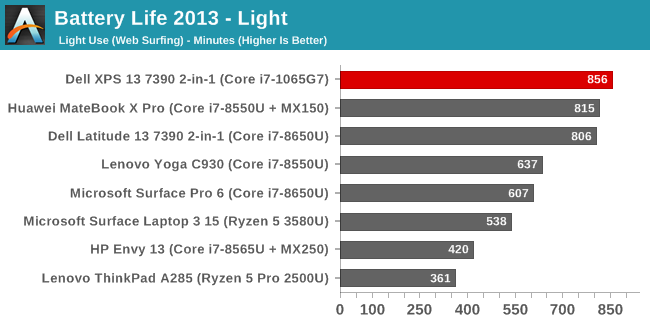
The XPS 13 7390 gets off to a strong start. Despite the larger physical display of the 16:10 13.4-inch panel, and the smaller battery capacity than some of the competition, the XPS 13 jumps to the top of the chart with over 14 hours of runtime on this light workload.
2016 Web

Our more demanding test always makes a big impact on efficient devices, forcing them to use the CPU a lot more and therefore using more power. But the Ice Lake platform does very well, maintaining its standing at the top with just a hair under 12 hours of runtime. Very impressive.
Movie Playback
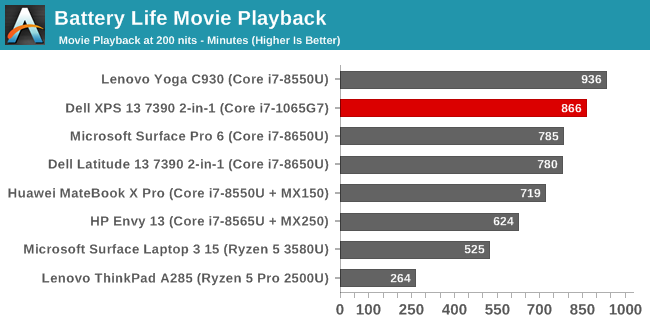
As we've seen in laptops over the last few years, Intel's now last-generation integrated UHD 620 GPU offers some spectacular battery life under video playback, as evidenced by how much longer these devices last in our video playback test, versus the more mixed workloads of our light web test. However things are a lot closer for the XPS 13; the Iris Plus (G7) GPU-equipped laptop only achieved ten minutes additional battery life over the light test. One device is not enough to make a definitive conclusion, but early indicators are that the norms for power consumption have changed on Intel's chips, and that movie playback and other ultra-light workloads that stress the GPU more than the CPU no longer hold a big advantage in power consumption. That being said, the device still achieved excellent battery life in this test, only being beaten by one other modern Ultrabook we’ve tested.
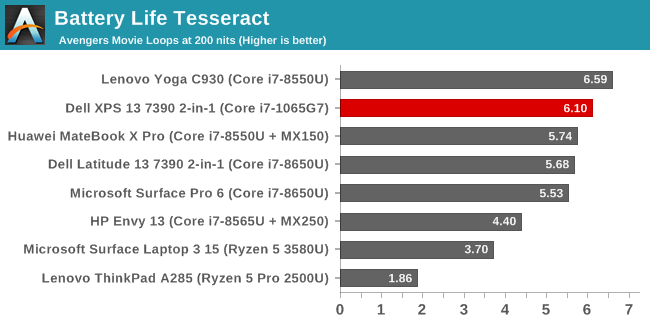
Our Tesseract score divides the movie playback time by the length of a long movie – The Avengers – to give a more practical view of the movie playback. If you had to, you could watch The Avengers six times in a row before needing to plug the laptop in.
Normalized Results

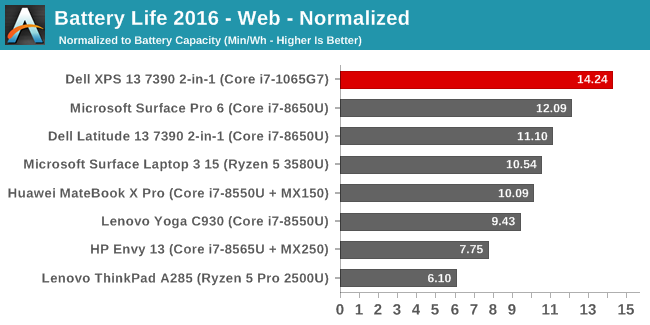
By removing the battery size from the equation we can get a peek at the platform efficiency, and the results are excellent for the first Ice Lake system we’ve tested. Much like how the first move to 14 nm in Broadwell brought a significant decrease in power usage, the XPS 13’s 10 nm Ice Lake platform achieves a significant step forward in efficiency in both our very light test, which is mostly idle time with small bursts of work, as well as the 2016 test which is much more demanding on the CPU.
The system power draw at idle, including the display power which is always the largest draw, is only around 3 Watts, which is quite good.
Battery Life Conclusion
Dell’s XPS 13 7390 2-in-1 brings a nice step forward in overall battery life, and unlike some of Dell’s earlier offerings it doesn’t try to do too much with excessive Content Adaptive Backlight Control which was a hindrance on older models of the XPS 13. For the current generation, CABC doesn’t appear to be leveraged at all.
With class-leading efficiency, the slightly smaller battery capacity is not a hindrance at all, with the Dell achieving excellent battery life results regardless of the 50 Wh of battery capacity.
Charge Time
Dell utilizes a Type-C charging adapter, which is always welcome on a modern laptop. The unit shipped with the XPS 13 2-in-1 is just a 45-Watt charger though, which is plenty to power this very efficient machine, but not enough power to provide much in the way of fast charging. With Express Charging enabled and the machine off, Dell claims 80% in one hour, but that goes down if the machine is on.
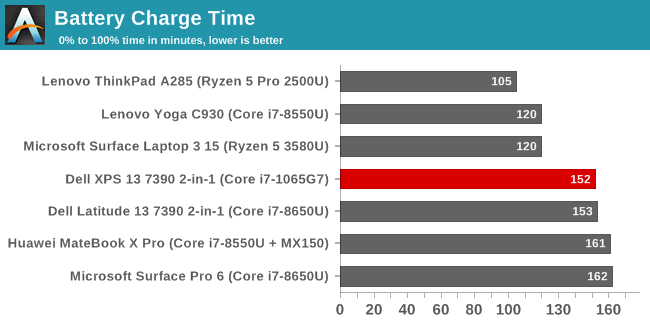
Overall charge time came in about average, at just a smidge over 2.5 hours. If you need more power and expansion, Dell offers a Type-C dock with a 130-Watt adapter, as well as a Thunderbolt dock with a 180-Watt power source.










108 Comments
View All Comments
tukkas - Friday, November 15, 2019 - link
I own one of these and have found the wake-up time (overnight for example) to be unremarkable. Perhaps it is going into hibernation? Could there be an incorrectly configured setting? thanksikjadoon - Friday, November 15, 2019 - link
That could be true: I thought, since these were "Project Athena" laptops, they'd have reliable wake-up times, but perhaps no?The "back-end" is just a mess: the OS version + OS settings+ the hardware + the firmware + the drivers + 3rd party programs all muck around with wake-up time.
It could be, unfortunately, any one of those things. I'm sad to hear about your story, though, as that kind of variability was supposed to have ended with Project Athena (i.e., not easily disturbed by user settings).
The easy answer would be an older firmware? Does yours have the latest UEFI/BIOS version? Anandtech doesn't mention what version they're using.
Reflex - Friday, November 15, 2019 - link
Not really having that experience. It would be impossible to benchmark IMO as when I open the lid, it's awake. Even when I leave it shut overnight it seems to wake up instantly in the morning.sorten - Friday, November 15, 2019 - link
Thanks to Microsoft's inability to implement TB3 ports on the Surface Pro line, I've been very tempted to jump to Dell. This XPS looks like it checks all boxes for me except that the keyboard doesn't detach.Another nice thing about Dell is that they don't start with a 128GB SSD and don't charge you $300 to move to 256GB for a drive that costs them less than $50.
HStewart - Saturday, November 16, 2019 - link
I have original XPS 13 2in1 and the XPS 15 2in1 which I typing this - and also Samsung Tab Pro S (original) and would save going 2in1 is better than detachable.Going Thunderbolt 3 is nice with the right dock.
stephenbrooks - Friday, November 15, 2019 - link
Storage seems subpar. I'd want 1TB if using this as a main machine.lazarpandar - Friday, November 15, 2019 - link
4tb m2 pcie ssd are out and only $650 so you can have all that and more ;)JanW1 - Monday, November 18, 2019 - link
No such luck. IIRC, there is no M.2 port on these. Both memory and SSD are soldered on-board and non-upgradeable.Reflex - Monday, November 18, 2019 - link
The battery is replaceable but aside from that its all soldered down. No glue though, easy enough to open and service.Reflex - Friday, November 15, 2019 - link
There is a 1TB and 32GB memory option.